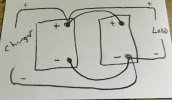I am not sure how many banks a charger should be for my boat. I have gotten different opinions from dealer, vendors, and internet 'gurus'
I have twin engines and four batteries.
There is one battery for the port engine, a second for the stbd motor and two parallel batteries for the house and accessories.
The engine batteries are each dedicated to the engines and do not 'connect directly to any other loads.
Each engine battery does use ACR that connects and charges to the two parallel house batteries. The two house batteries are hard connected to each other always.
I want to install a charger. The first two banks are obvious, the two engine batteries. My confusion has to do with the two parallel house batteries.
I am an electrical engineer (long retired) and can understand both arguments for a single bank for the two house batteries as well as the argument that the proper approach is a separate bank for each house battery even though they are hard wired to each other.
For situations where batteries are wired in series, for example 2 12v series for a 24v thruster, I completely understand why the correct scheme for a 12v charger is one bank for each battery.
Honestly in my situation I think either approach would be fine with not much if any disadvantage to wiring a only one back to the parallel batteries.
Any thoughts?
I have twin engines and four batteries.
There is one battery for the port engine, a second for the stbd motor and two parallel batteries for the house and accessories.
The engine batteries are each dedicated to the engines and do not 'connect directly to any other loads.
Each engine battery does use ACR that connects and charges to the two parallel house batteries. The two house batteries are hard connected to each other always.
I want to install a charger. The first two banks are obvious, the two engine batteries. My confusion has to do with the two parallel house batteries.
I am an electrical engineer (long retired) and can understand both arguments for a single bank for the two house batteries as well as the argument that the proper approach is a separate bank for each house battery even though they are hard wired to each other.
For situations where batteries are wired in series, for example 2 12v series for a 24v thruster, I completely understand why the correct scheme for a 12v charger is one bank for each battery.
Honestly in my situation I think either approach would be fine with not much if any disadvantage to wiring a only one back to the parallel batteries.
Any thoughts?


